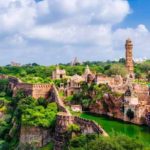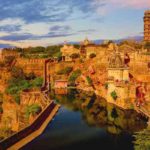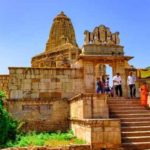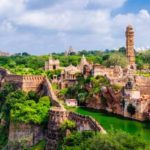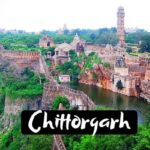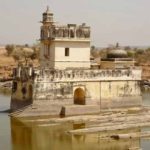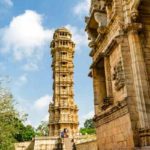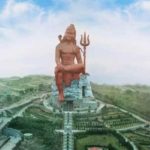Places to See in Chittorgarh is an important city in the southern part of the state, located in Rajasthan. The land of Chittorgarh is synonymous with courage and warriors, and some of the famous names who sacrifice their lives for their motherland and honour are renowned for that. Queen Padmini, Rani Karnawati, Maharana Pratap, Rao Jaimal, Meera Bai and many others are such names. The city is nestled on the banks of the Gambhir River and the Berach River, which is a tributary of the Banas. The town used to be the headquarters of the ruler of Mewar’s Sisodia clan.
Chittorgarh is famous for its fort, which is considered not only to be the largest in India, but also in Asia. Allauddin Khilji attacked the city fort, and the history of the city is very famous, as it is mainly linked to the fort.
The fort was invaded again by several rulers and attacks survived and “Jauhar” was committed by the Rajput queens to defend their integrity as it began with Queen Padmini and was followed by Queen Karnawati.
Places to See in Chittorgarh, there are many historical attractions that are truly popular and they are renowned for their iconic architecture.
There are many festivals that visitors enjoy, such as Teej, Gangaur, The Tribal Fair and, most notably, the Jauha meal to honour Queen Padmini’s Jauhar. There are many festivals.
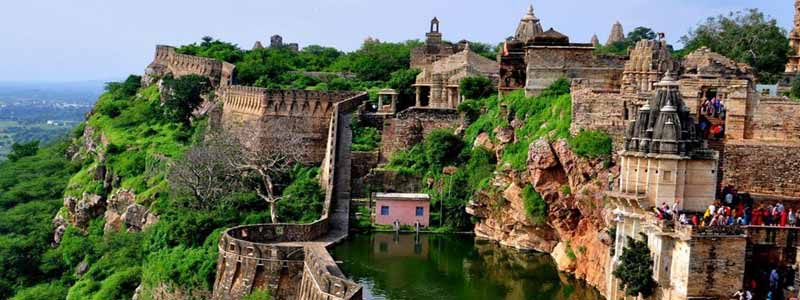
Chittorgarh Fort
One of the most interesting places to visit in Chittorgarh is Chittorgarh Fort. This historic fort is the pride of the city of Rajasthani as it stands impressively on top of a hill, looking down over the city protectively. Almost all of the attractions in Chittorgarh are located within the fort.
A fitting emblem of the Rajput spirit is Chittorgarh Fort. Built on top of a hill 180 metres high and spread over 240 hectares, this magnificent fort features tales of bravery, pride and romance that have been sung for centuries by the bards of Rajasthan. Legend has it that Bhim, one of the heroic Pandava brothers from Mahabharata, India’s eminent mythological epic, started the building of the Chittorgarh Fort. Several majestic monuments are located in the fort, some sadly ruined by the passing of time Places to See in Chittorgarh.
The majestic structure brings one back to the days of conquests and tragedies, and its walls continue to ring with unbelievable tales of unusual men and women. A one-kilometer road weaves its way to the summit from the foothills, Until arriving at Rampol, it brings tourists through seven gates (Gate of Ram). Visitors will see two ‘chattris‘ (cenotaphs) constructed in honour of Jaimal and Kalla, heroes who laid down their lives in the 1568 siege of Emperor Akbar, on the road between the second and third gates. Surajpol, the main gate of the fort, is (Sun Gate).
The fort is known as Padan Gate for its seven gates, Ganesh Gate, Hanuman Gate, Bhairon Gate, Jodla Gate, Lakshman Gate, and Lord Ram’s main gate. Many palaces are located in the Chittorgarh Fort, such as the Rana Kumbha Palace, the Fateh Prakash Palace, the Victory Tower and the Palace of Rani Padmini. For their Rajput architectural characteristics, all these structures are important. Inside the fort, there are several temples as well. A big attraction is a vast complex of Jain temples. In 2013, Chittorgarh Fort was declared a UNESCO World Heritage Site, along with other hill forts in Rajasthan.
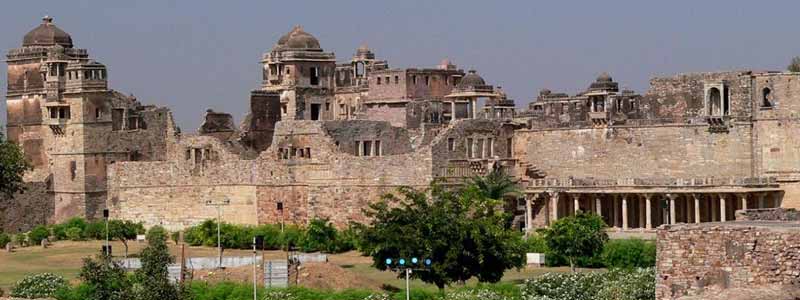
Rana Kumbha Palace
In Chittorgarh, Rana Kumbha Palace is located. This palace is one of Rajasthan’s largest monuments, a mammoth monument from the 15th century, enclosed within the Chittorgarh Fort‘s interior. The Rajput King, Maharana Kumbha, lived his royal life in this palace. The Palace of Rana Kumbha is a fine example of Rajput architecture.
It is believed that the palace has underground cellars and folk tales woven around it, saying that Rani Padmini and other women in the royal palace performed Jauhar in these cellars. Nearby, there is a grand old temple dedicated to Lord Shiva and stables of horses and elephants.
The palace of Rana Kumbha is a palace in the 15th century where Rana Kumbha lived and spent his royal life. Due to its charming and artistic architecture, this historic monument is very famous amongst tourists.
Udaipur’s founder, Maharana Udai Singh, was born in the same palace. Rana Kumbha’s cellar palace, where brave Rani Padmini, along with other women, performed an act of jauhar during a Khilji attack. In the nearby Lord Shiva temple and the light and sound display in its complex brings tourists closer to the history of Chittorgarh Fort.
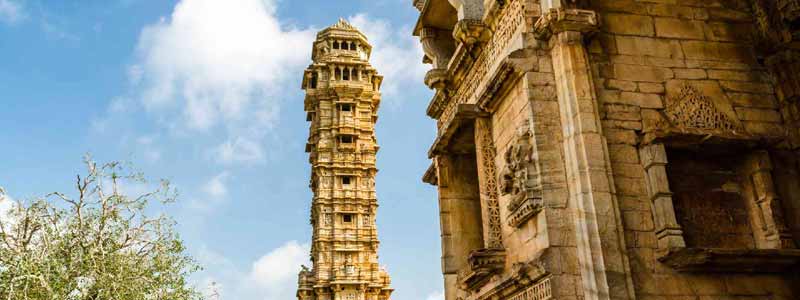
Tower of Fame (Kirti Stambh)
Kirti Stambh is an ancient Jain monument within the Chittorgarh Fort Complex, or the Tower of Fame. Kirti Stambh is a tower built in the 12th century during the reign of Rawal Kumar Singh by a Jain merchant, Jijaji Bhagerwala. Glorifying Jainism was the primary aim behind its commission. This six-story tower, 22 m high, is dedicated to the first Jaina Thirthankara, Adinath.
It has several columned balconies, latticed arches and intricately carved niches, constructed in the Solanki architecture style. The tower is decorated with numerous naked Thirthankar figures, suggesting that it belonged to the sect of the Digambara. On the lower level, standing Adinatha images are seen in all four cardinal directions, while the upper floors contain hundreds of images of miniature images of Jain divinities. Within and outside the tower, a number of Jain inscriptions can be identified, dating it to 896 AD.
There is a narrow stairway that leads to the top through the seven floors. There is an observation hall on the top floor that provides a panoramic view of Chittorgarh city. In order to worship Lord Adinath, a large number of followers of Jainism come to the tower. This monument is closed, however, only tourists can go inside the monument. Outside one can visit it.
Vijay Stambha (Victory tower)
The Vijay Stambha or Victory Tower is one of India’s most prominent monuments and is an important Rajasthan tourist attraction. The Tower of Victory, located in Chittorgarh Fort in Rajasthan, India, was built between 1442 AD and 1449 AD by Mewar King Rana Kumbha to honour his distinguished victory over the joint attacks of Malva Sultan Mohammad Khilji and Gujarat Sultan Kutubuddin Shah.
Its elegant and immaculate architecture is unique. This 37.19-m high tower, dedicated to Vishnu, was built on a 14-m square base. The width of its base is 9 m. The Tower is partly made of red sand stone and partly white marble.
The interior and exterior are delicately carved, depicting Hindu deities with names and mythological characters. There is a genealogy of the rulers of Chittaur from Hamir to Rana Kumbha in the inscribed slabs in the uppermost narrative. Architectural ornaments and inscribed images of gods and goddesses, seasons, arms, musical instruments, etc. are covered in the tower. A real text-book of Hindu iconography is its engraved sculpture. On the fifth floor of the tower are carved portraits of the architect of this tower, Jaita and his 3 sons, Napa, Puja, and Poma.
Padmini’s Palace
The Palace of Rani Padmini is a white three-story building situated in the southern part of the fort of Chittorgarh; it was built in the 19th century. The Palace of Rani Padmini stands as the prime attraction of Chittorgarh Fort, one of the world’s finest examples of architecture. Rani Padmini Palace is the main attraction of the Chittorgarh Fort’s 700-acre premises.
The legend of Rani Padmini goes along with the palace that can be seen at Chittorgarh Fort from the top of the 590-feet-tall-hill. The majestic appearance and the perfect altitude of the place make it a perfect place from which you can discover the Chittorgarh’s uninterrupted views and also the palace where the Rajputana’s most beautiful woman once stayed. Due to its historical significance, Rani Padmini’s Palace is also unique.
In addition to the Palace of Rani Padmini, the Chittorgarh Fort Complex also has prominent structures that make the 12th and 13th centuries a living example of architecture. There are also Jain temples, pillars studded with ornaments, Gaumukh reservoir, the temple of Meerabai where she adored Lord Krishna, Some of the prominent structures that make up the prominent sightseeing attractions at Chittorgarh Fort are Rana Kumbha’s Palace, one of the most massive monuments in the fort.
Kalika Mata Temple
Kalika Mata temple is one of the most interesting locations in Chittorgarh. This temple dates from the 14th century. The temple situated across the Padmini Palace was originally a temple of the Sun God, built here during the 8th century, it was said. This temple was destroyed by Allaudin Khilji after the attack. Dedicated to Kali the Goddess (one of the forms of Maa Durga), This temple is an architectural jewel of the Pratihara period. Thus, not only is this temple a popular religious site, it is also very popular among tourists and art lovers visiting Chittorgarh.
Kalika temple in Chittorgarh is built on an elevated podium and has a mandap, entrance door, ceiling and pillars intricately sculpted. However, when the area was targeted by Allaudin Khilji, a major part of the temple was destroyed. The temple is situated between Padmini Palace and the Victory Tower, two of Chittorgarh’s most popular tourist attractions. There is also a large empty area in the temple complex where the ‘Ratri Jagrans‘ are organised. The temple of Kalika mata is placed on a rock with its entrance gate to the east. A temple dedicated to Lord Shiva also exists in the temple complex. This temple is named Mahadev Jogeshwar.
Sanwariaji Temple
On the Chittorgarh – Udaipur Highway, in the town of Mandaphia, about 40 kilometres from Chittorgarh, the Sanwaliaji Temple of the Dark Krishna is located. The god is also referred to as Shri Sanwaria Seth.
Considered second only to the Krishna Temple in Nathdwara in religious significance, the Sanwariyaji Temple is thronged by devotees who wish to seek blessings. The temple is situated on the Udaipur-Chittorgarh Highway, at a distance of about 40 km from Chittorgarh, making for a pleasant early morning drive. A few steps into the temple, and in a strong positive, pious energy, you will find yourself enveloped. This temple is considered to be the luckiest temple for businessmen, and you’ll be shocked to know that, Many of Rajasthan’s rich merchants have struck a profit-sharing deal with God.
The temple has been under renovation recently, and a massive new temple is being built in place of the old building. For devotees who want to stay in the premises and do ‘Seva‘, the new temple will also have guest houses Places to See in Chittorgarh.
Sanwariaji Temple is situated in the town of Mandaphia, along the Chittorgarh-Udaipur Highway, 40 km away from Chittorgarh. This temple has a dark skinned lord, Krishna, who is regarded by many Hindu devotees as auspicious and has become a popular place of pilgrimage.
Ratan Singh Palace
Ratan Singh Palace or Ratan Singh Mahal, located in Chittorgarh Fort, is a big historical palace. Situated along the Talab of Ratneshwar, this palace is one of Chittorgarh’s top places to visit.
Rana Ratan Singh II is assigned to the Ratan Singh Palace (AD 1528 – 31). On a plane, it is rectangular and surrounded by a high wall. Via a lofty arch crowned with two pillared chhatris, the principal entrance faces east. On the eastern part of the second floor, the palace features a courtyard surrounded by rooms and a pavilion with a balcony.
There is a gate on the north side of the palace that leads to the inner part of the palace. There is a large empty space in the inner part and numerous old buildings and rooms are constructed around it. On the eastern side of the second floor, Darikhana has a fine balcony overlooking the reservoir. To the north of the main gateway, which consists of a garbhagriha, an antarala and a mandapa, is a temple known as Ratneshwar Mahadeva Temple. The temple’s exterior is beautifully carved. In the palace compound, one can also see a well tended garden. This palace was used in ancient times for great occasions and ceremonies Places to See in Chittorgarh.
Samadhisvara Temple
The Temple of Samadhishvara, Chittorgarh, Rajasthan, is a temple dedicated to the Hindu god Shiva, who is the destructive part of Brahma the creator’s Hindu trinity, Vishnu the preserver, and Shiva the destroyer. The temple’s sanctum sanctorum has a huge three-headed Shiva statue. From the ground, this idol rises and almost covers the entire wall.
It should be noted that this idol of Trimurti displays three distinct Shiva attitudes and is not to be confused with Brahma, Vishnu, and Maheshwara’s Trimurti.
On all three heads, the third eye of Shiva can be seen. The face on the left has a fierce smile and the fearful Aghora aspect of Shiva is believed to be represented. While the face on the left is composed and has an atmosphere of serenity, the central face appears to have an expression of sardonic humour. One of the hands is raised in Sarpa Mudra, while the other hands hold various things associated with the sign of Shiva, including the Rudraksha and the fruit of Matulunga. Six hands can be seen.
Meera Temple
Meera Chittorgarh Temple Were you ever in Rajasthan? If not, then you haven’t visited one of the world’s best tourist destinations yet. Rajasthan’s range of attractions makes its appeal ideal for visitors of all kinds. As a consequence, it draws visitors from faraway parts of the planet. The range of attractions makes it a very fun tour for all visitors. In Rajasthan, there are a variety of places which are thronged by a large number of tourists.
One such place that has a wide range of tourist attractions is Chittorgarh. The prime attraction is the historical importance of the site. However, the location also has a variety of other attractions. One of the most famous temples in Chittorgarh is the Meera Temple. The temple is dedicated to Meera Bai and has both historical and religious importance. During the Chittorgarh tours, a visit to this temple is obligatory.
Gaumukh Reservoir
At Chittorgarh Fort, Gomukh kund (Gaumukh Reservoir) is situated. Gomukh means Cow’s Mouth. Water flows from the point created by the cow’s mouth, which is why it’s called Gomukh. This Kund is also known as Chittorgarh’s ‘Tirth Raj’. Whenever pilgrims and devotees go on a tour of various spiritual Hindu sites, they come to Gomukh Kund to complete their holy journey after coming to Chittorgarh.
The water flows into the Kund from the cow’s mouth (Reservoir). The flow of water continues for 365 days, but the flow rate of water is sluggish in the summer. Water flows from a gap in the rock and falls into Gomukh’s reservoir, but it is still not entirely clear where this water continues to come from.
The Reservoir, which draws many visitors, is located in a scenic area. In ancient times, this reservoir was a great water supply. The statue of Lord Shiva Ling and Goddess Lakshmi is located at the point where the water falls from the mouth of the cow. With a lot of green plants and flowing water, the natural environment makes everyone visit this location again and again. Great views of the whole city can also be taken from here.
Sita Mata Wildlife Sanctuary
The wildlife sanctuary of Sita Mata is a lovely, pious place famous for its rich vegetation. Along with uncommon species of animals, this place contains a wide range of plant species and medicinal herbs. Five rivers flow along with other water bodies in this sanctuary. Birds have contributed to this place’s appeal. Numerous bird species frequent this sanctuary, along with migratory birds.
There is a common belief that the Valmiki Maharishi ashram was situated here in ancient times. The goddess Sita Devi, Lord Rama’s wife, gave birth to her two sons, Lava and Kusa. Within the sanctuary, there is a Sita Devi shrine. Therefore, to worship the goddess, many devotees visit this sanctuary. This sanctuary is, in reality, believed to be related to the goddess Sita. The name of the deity is then granted to the sanctuary.
A few stones found by archaeologists are the historical value of this site. That has drawn visitors to the animal painting of prehistoric events. The sanctuary is situated in Rajasthan’s Pratapgarh and Chittorgarh districts. Hence, Udaipur is the closest airport to the sanctuary. Whereas in Mandsaur, the railway station. Whereas the mode of transport based on one’s comfort can be selected from here.

